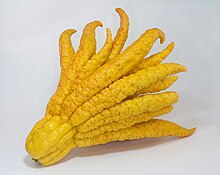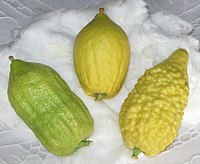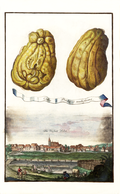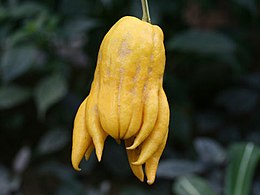| This article needs additional citations for verification. Please help improve this article by adding citations to reliable sources. Unsourced material may be challenged and removed. Find sources: "Buddha's hand" – news · newspapers · books · scholar · JSTOR (February 2020) (Learn how and when to remove this message) |
| Fingered citron | |
|---|---|

| |
| Buddha's hand fruit, "open hand" appearance when ripe | |
| Scientific classification | |
| Kingdom: | Plantae |
| (unranked): | Angiosperms |
| (unranked): | Eudicots |
| (unranked): | Rosids |
| Order: | Sapindales |
| Family: | Rutaceae |
| Genus: | Citrus |
| Species: | C. medica |
| Variety: | C. m. var. sarcodactylis |
| Trinomial name | |
| Citrus medica var. sarcodactylis (Hoola van Nooten) Swingle | |
| Citron varieties |
|---|
 |
| Acidic-pulp varieties |
| Non-acidic varieties |
| Pulpless varieties |
| Citron hybrids |
| Related articles |
| Buddha's hand | |||||||
|---|---|---|---|---|---|---|---|
| Chinese name | |||||||
| Chinese | 佛手柑 | ||||||
| |||||||
| Vietnamese name | |||||||
| Vietnamese | quả phật thủ | ||||||
| Korean name | |||||||
| Hangul | 불수감 | ||||||
| Hanja | 佛手柑 | ||||||
| |||||||
| Japanese name | |||||||
| Kanji | 仏手柑 | ||||||
| |||||||
Citrus medica var. sarcodactylis, or the fingered citron, is a citron variety whose fruit is segmented into finger-like sections, resembling those seen on representations of the Buddha. It is called Buddha's hand in many languages including English, Chinese, Japanese, Korean, Vietnamese, and French.
The different cultivars and variations of this citron variety form a gradient from "open-hand" types with outward-splayed segments to "closed-hand" types, in which the fingers are kept together. There are also half-fingered fruits, in which the basal side is united and the apical side fingered. The origin of this kind of citron is commonly traced back to South or East Asia, probably northeastern India or China, where most domesticated citrus fruits originate.
Description
Citrus medica var. sarcodactylis is, like any other citron variety, a shrub or small tree with long, irregular branches covered in thorns. Its large, oblong leaves are pale green and grow about four to six inches. Its white flowers are tinted purplish from the outside and grow in fragrant clusters. The fruit's fingers contain only the white part of the fruit and sometimes a small amount of acidic pulp, but many of them are completely juiceless and some are seedless.
The plant is sensitive to frost, as well as intense heat and drought. It grows best in a temperate climate. Trees can be grown from cuttings taken from branches two to four years old. It is very commonly grafted onto sufficient rootstock.
Uses
Perfumery
Buddha's hand fruit is very fragrant and is used predominantly in China and Japan for perfuming rooms and personal items such as clothing.
Religious
The fruit may be given as a religious offering in Buddhist temples. According to tradition, Buddha prefers the "fingers" of the fruit to be in a position where they resemble a closed rather than open hand, as closed hands symbolize to Buddha the act of prayer. In China, the Buddha's hand fruit is a symbol of happiness, longevity, and good fortune. It is also a traditional temple offering and a New Year's gift.
Whether a Buddha's hand is acceptable for liturgical use as an etrog on Sukkot was addressed in the 19th century by Rabbi Abdallah Somekh and his disciple, Rabbi Yosef Hayyim, both of Baghdad. The former was inclined to permit it, whereas the latter maintained that one may not use a variety of etrog in the absence of a positive tradition of its having been used.
Ornamental
The fingered citron is cultivated as an ornamental tree in gardens and containers on patios and terraces. In the United States, its unripe fruits have been sold under the trademark goblin fingers as a decorative Halloween novelty.
Food and medicine
Unlike other citrus fruits, most varieties of the Buddha's hand fruit contain no pulp or juice. Though esteemed chiefly for its "exquisite form and aroma", the Buddha's hand fruit can also be eaten (often as a zest or flavouring) in desserts, savory dishes, and alcoholic beverages (such as vodka or rice liquor) or candied as a sweet. The sliced, dried peel of immature fruits is also prescribed as a tonic in traditional medicine.
Gallery
-
 A fingered citron by Volckamer
A fingered citron by Volckamer
-
 Fingered citron by Wellcome Trust
Fingered citron by Wellcome Trust
-
Huge fruit breaking bearing twig
-
 Buddha's hand citron in Val Rahmeh botanical garden
Buddha's hand citron in Val Rahmeh botanical garden
-
Semi-fingered and closed
-
 Closed fingers
Closed fingers
-
 Side view
Side view
-
 A fingered citron
A fingered citron
-
 Semi-closed fingers
Semi-closed fingers
-
 In Villa di Castello
In Villa di Castello
-
 Semi dwarf fingered citron (green)
Semi dwarf fingered citron (green)
-
 With open fingers
With open fingers
-
 Cross section in a Variety etrog citron, and in fingered citron
Cross section in a Variety etrog citron, and in fingered citron
See also
References
- Karp, David (Winter 1998). "Buddha's Hand Citron". Flavor and Fortune. 5 (4). Kings Park, NY: Institute for the Advancement of the Science and Art of Chinese Cuisine: 5–6. Archived from the original on 2011-06-06. Retrieved 2010-04-20.
- "Citrus medica var. Buddhas Hand". Catalog of the Living Plant Collections. Storrs, CT: University of Connecticut, Department of Ecology & Evolutionary Biology, Plant Growth Facilities. Retrieved 2010-04-20.
- ^ "Buddha's hand citron". Catalog of the Citrus Variety Collection. Riverside, CA: University of California, Riverside, Department of Botany and Plant Sciences, Citrus Experiment Station. Retrieved 2010-04-20.
- "Buddhas Hand". Melissa's Produce.
- "Responsa Zivhei Tzedek, Orah Hayim §37".
- Goldschmidt, Eliezer E.; Bar-Joseph, Moshe (7 June 2023). The Citron Compendium: The Citron (Etrog) Citrus medica L.: Science and Tradition. Springer Nature. ISBN 978-3-031-25775-9.
External links
 Media related to Buddha's hand at Wikimedia Commons
Media related to Buddha's hand at Wikimedia Commons- Pictures
| Taxon identifiers | |
|---|---|
| Citrus medica var. sarcodactylis | |